
|
Sale 132
The New York Sale
| Lot |
Photo |
Description |
Realized |
Lot 1 |
 |
Etruria, Populonia. Silver 20 Asses (8.32 g), 3rd century BC. Diademed facing head of Metus; below, X:X. Reverse: Blank. EC I, ser. 37; HN Italy 142. Lightly toned and needle sharp. Superb Extremely Fine. Estimated Value $2,000 - UP
Ex Bertolami 109 (4 May 2022), 5.
View details and enlarged photos
Realized
$4,800 |
|
Lot 2 |
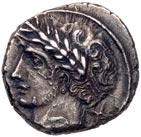 |
Etruria, Populonia. Silver 10 Asses (4.15 g), ca. 300-250 BC. Laureate and slightly bearded head of Aplu to left; to right, X. Reverse: Blank. EC grp. XVI, ser. 70 (O1); HN Italy 168. Toned. Extremely Fine. Estimated Value $500 - UP
Like many aspects of Etruscan culture, Etruscan coins have a distinctive character. In contrast to most contemporary Greek and native Italian coinages, the flan of this Populonian silver issue was struck by a single die against a flat surface rather than an anvil die, leaving it with only a single type (technical reverse) and an enigmatic blank side (technical obverse). In this case the type depicts Aplu, the Etruscan version of the Greek god Apollo, and features the numeral X to indicate a face value of 10 bronze asses. A similar value indicator was later adopted by the Romans to indicate the number of asses in the silver denarius.
Ex Leu Winterthur 19, 55.
View details and enlarged photos
Realized
$1,320 |
|
Lot 3 |
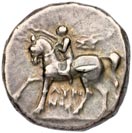 |
Calabria. Tarentum. Silver Stater (6.49 g), ca. 272-240 BC. Reduced standard. Nude youth on horseback left, crowning horse, ΣY behind, ΛYKI/NOΣ between horse's legs. Reverse; Phalanthos riding dolphin left, preparing to throw trident, owl behind. Vlasto 836-41; HN Italy 1025. Very Fine. Estimated Value $400 - UP
View details and enlarged photos
Realized
$456 |
|
Lot 4 |
 |
Lucania, Poseidonia. Silver Nomos (7.53 g), ca. 530-500 BC. ΠOΣ, Poseidon, nude but for cloak over shoulders, advancing right, stretching forth arm and wielding trident. Reverse: ΠOΣ (in relief), Incuse of obverse. SNG Locker Lampson 25; Gillet photo file 207 (same dies); HN Italy 1107. An exceptionally fine example, of superb early Archaic style. Perfectly centered and finely detailed, and with hint or light iridescent toning. The metal of exceptional quality. One of the finest examples of this early archaic style, and certainly worthy of a record price! Nearly Mint State. Estimated Value $25,000 - UP
Poseidonia, a city on the western coast of Italy bordering the Tyrrhenian Sea, was founded by colonists from Sybaris sometime during the final years of the 7th century BC. Although the ruins of Poseidonia today are principally known or its three majestic Doric temples, none of these have been identified as temples of Poseidon. In fact, no temple to Poseidon has ever been definitively identified in the city's remains, although as evidenced here by the types on this truly magnificent nomos and also in the city's name, the cult of the god must have played an very significant role for the city's early inhabitants. According to historical tradition, there existed a sanctuary to Poseidon on the promontory below the city, and it is likely that Poseidonia takes its name from this sanctuary.
Ex Roma XIII (23 March 2017), 30.
View details and enlarged photos
Realized
$99,000 |
|
Lot 5 |
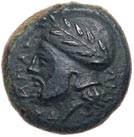 |
Sicily, Entella. Campanian Mercenaries. Æ Litra, 18mm (6.52 g), ca. 370-350 BC. KA-MPAN-ΩN, bearded male head left, wearing Corinthian helmet decorated with a laurel wreath. Reverse: Bridled horse galloping right; Corinthian helmet below. CNS 9; SNG ANS -. Very Rare. Well struck and perfectly centered. Dark green - nearly black - patina. Of outstanding quality! Superb Extremely Fine. Estimated Value $400 - UP
Ex Triton VI (15 January 2003), 95.
View details and enlarged photos
Realized
$552 |
|
Lot 6 |
 |
Sicily, Entella. Silver Tetradrachm (16.92 g), ca. 320/15-300 BC. Siculo-Punic issue. Head of Arethusa left, wreathed with grain ears, wearing triple-pendant earring and necklace; four dolphins around. Reverse: 'Mem', Horse's head right; behind, palm tree. Jenkins 263 (O81/R219); SNG Lloyd 1641 (same obv. die). Superb and lustrous. Lightly toned. Nearly Mint State. Estimated Value $2,000 - UP
Probably struck during or in preparation for the great conflict between Punic Carthage and Syracuse under the tyrant Agathokles that raged from 315-307 BC, this tetradrachm illustrates the immense impact of Greek culture on the development of Siculo-Punic coinage. The obverse depiction of the Semitic deity Tanit is lifted directly from Syracusan tetradrachms featuring Persephone-Arethusa - even down to the encircling dolphins. The horse's head reverse may allude to the foundation myth of Carthage, in which the city was founded by Dido of Tyre on a hill where the head of a horse was uncovered. This was an omen of the city's future prowess in war. The small palm tree in the background is a Greek pun on the Phoenician origin of Punic Carthage: the geographical name Phoenicia is derived from phoinix, the Greek word for palm tree.
View details and enlarged photos
Realized
$4,080 |
|
Lot 7 |
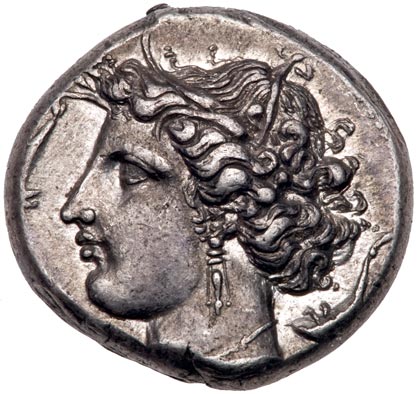 |
Sicily, Entella. Silver Tetradrachm (16.71 g), ca. 320/15-300 BC. Siculo-Punic issue. Head of Arethusa left, wreathed with grain ears, wearing triple-pendant earring and necklace; four dolphins around. Reverse: 'Mem', Horse's head right; behind, palm tree. Jenkins 246 (O77/R208); Hunter 4 (same obv. die). Well centered with underlying luster present, and lightly toned. Appears to have possibly been overstruck on an earlier tetradrachm. An elegant coin. About Extremely Fine. Estimated Value $1,500 - UP
View details and enlarged photos
Realized
$3,120 |
|
Lot 8 |
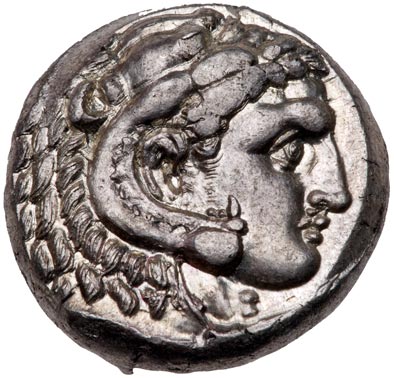 |
Sicily, Entella. Silver Tetradrachm (17.43 g), ca. 300-289 BC. Head of Herakles right, wearing lion's skin headdress. Reverse: 'MMHNT, Horse's head left; behind, palm tree. Jenkins 290 (O93/R238); McClean 3047 (same dies). A perfectly centered and well struck example. Lustrous and superb. Superb Extremely Fine. Estimated Value $2,000 - UP
The Punic inscription on this coin names "the People of the Camp" and leaves no doubt about its use to pay the numerous foreign (primarily Italic) mercenaries that swelled the armies of Carthage during its conflict with the Greek cities for dominance on Sicily. "People of the Camp" issues are usually attributed to Entella, a frequent stronghold of Campanian mercenaries in the fourth and third centuries BC. The obverse of the coin features a depiction of Herakles drawn from the popular tetradrachms of Alexnder the Great - a type widely accepted by foreign mercenaries throughout the Mediterranean world - while the reverse features the head of a horse and a palm tree. The palm tree (phoinix in greek) alludes to the Phoenician origin of the Punic peoples of North Africa while the horse refers to the somewhat bizarre tradition that Carthage was founded by the Tyrian queen Dido on a hill where the head of a horse was unearthed.
View details and enlarged photos
Realized
$5,280 |
|
Lot 9 |
 |
Sicily, Gela. Æ Tetras, 16 mm (3.38 g), ca. 420-405 BC. ΓEΛAΣ, bull standing right, head lowered; above, barley grain; in exergue, three pellets. Reverse: Head of young river-god right, with flowing hair; behind, barley grain. Jenkins 507; CNS 18. Lovely olive-geen patina. Superb Extremely Fine. Estimated Value $350 - UP
Ex NYS XIV (10 January 2007), 38.
View details and enlarged photos
Realized
$456 |
|
Lot 10 |
 |
Sicily, Himera. Æ Hemilitron, 13mm (1.80 g), ca. 412-409 BC. Head of nymph facing slightly left. Reverse: IME, crayfish left; six pellets above. CNS 36; SNG ANS -. Lovely green patina. NGC grade Ch AU; Strike: 4/5, Surface: 5/5. Estimated Value $350 - UP
View details and enlarged photos
Realized
$504 |
|
Lot 11 |
 |
Sicily, Himera. Silver Tetradrachm (17.35 g), ca. 409-407 BC. Obverse die signed by the artist Mai… The nymph Himera driving quadriga galloping to right; above, Nike flying left, crowning the nymph with wreath and holding plaque inscribed MAI; in exergue, ketos left. Reverse: HI-MEP-AION (retrograde), The nymph Himera standing facing, head left, pouring libation over altar from patera; to right, satyr standing to right in a fountain basin, showering under a stream of water emanating from a lion's head spout. Arnold-Biucci grp. IV, 22 (Q8/H17); Gutmann & Schwabacher 20 (same dies); Rizzo pl. XXI, 23 = de Luynes 977 (same dies); Gillet 434 (same dies). Beautiful light toning, sharp strike, and excellent metal. Underlying luster thoughout the fields. Superb Extremely Fine. Estimated Value $10,000 - UP
This tetradrachm belongs to the celebrated Sicilian tradition of coin dies signed by their highly skilled engravers. The MAI who signed this issue also signed dies that he engraved for Syracuse. Despite the high artistry of the coin, it was struck on the eve of disaster for Himera. In 410 BC, a Carthaginian expeditionary force under Hannibal Mago intervened in a conflict between Segesta and Selinous which resulted in the defeat of the latter and the destruction of Selinous in 409 BC. Although not part of his mandate, Mago followed this victory by besieging and destroying Himera in revenge for the defeat of his grandfather by the Himerites some 60 years earlier. This tetradrachm may have been hopelessly struck in part to hire mercenaries and improve the poor fortifications of Himera in response to the threat of the Carthaginian army.
Ex NAC 120 (6 October 2020), 255.
View details and enlarged photos
Unsold |
|
Lot 12 |
 |
Sicily, Kamarina. Æ Onkia 13 mm (1.71 g), ca. 339-300 BC. Female head left. Reverse: KAMAPINAIΩN, bull butting left. Westermark & Jenkins 218; CNS 45; SNG ANS 1312. Well struck in high relief. Dark green patina. Superb Extremely Fine. Estimated Value $300 - UP
Ex Roma XIII (23 March 2017), 78.
View details and enlarged photos
Realized
$300 |
|
Lot 13 |
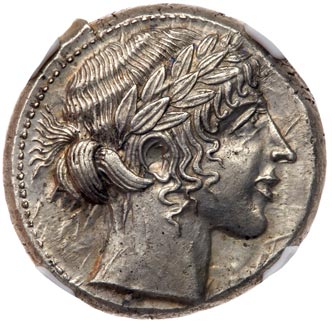 |
Sicily, Leontinoi. Silver Tetradrachm (17.38 g), ca. 450-440 BC. Laureate head of Apollo right. Reverse: LEO-N-TI-NO-N, head of roaring lion right; around, four barley grains. Boehringer 37 (same obv. die); SNG ANS 227 (same dies); SNG Lloyd 1055 (same obv. die); Jameson 629 (same obv. die); Rizzo pl. XXIII, 1 (same obv. die). Excellent metal and lustrous. Light tone. Nearly Mint State. Estimated Value $6,000 - UP
Like other Greek settlements in Sicily, Leontini was freed from the rule of tyrants in th 460s BC, which was reflected in design changes on its coinage. The chariot of the obverses, a design copied from Leontini's neighbor Syracuse, became instead the laureate head of Apollo, which was taken from the earlier reverse. In its place a new type, a lion' head fountain, was employed, the main design surrounded by four barley grains, an allusion to the city's agricultural wealth. These new types are punning types reflecting the city's patron deity, Apollo, and the lion that was sacred to him and from which Leontini derived its name (lion is leon in Greek).
Ex Roma XIX (27 March 2020), 281; NAC 114 (6 May 2019), 51 (hammer CHF 13,000); purchased privately from A. Tkalec AG in 1995.
View details and enlarged photos
Realized
$19,200 |
|
Lot 14 |
 |
Sicily, Lilybaion. Silver Tetradrachm (17.29 g), ca. 350-310 BC. 'RSMLQRT' in exergue, charioteer, holding kentron and reins, driving slow galloping quadriga right; above, Nike flying left, crowning charioteer with wreath. Reverse: Head of Arethusa right, hair bound with sphendone, wearing triple-pendant earring, and necklace; around, three dolphins. Jenkins 5 (O4/R4); Jameson 1903 = BMFA Add. 24 (same dies). Light violet tone. A very artistic, fine style example. Choice Very Fine. Estimated Value $1,500 - UP
View details and enlarged photos
Realized
$2,220 |
|
Lot 15 |
 |
Sicily, Syracuse. Deinomenid Tyranny. Silver Tetradrachm (17.17 g), 485-466 BC. Under Hieron I, ca. 478-475 BC. Charioteer driving quadriga right, holding kentron and reins; above, Nike flying right, crowning horses. Reverse: ΣVRAKOΣION, diademed head of Arethusa right; four dolphins around clockwise. Boehringer Series VIIib, 171 (V74/R120); HGC 2, 1306. Old cabinet tone. Very Fine. Estimated Value $750 - UP
Ex Sigmund Collection (CNG E500, 22 September 2021), 74.
View details and enlarged photos
Realized
$2,760 |
|
Lot 16 |
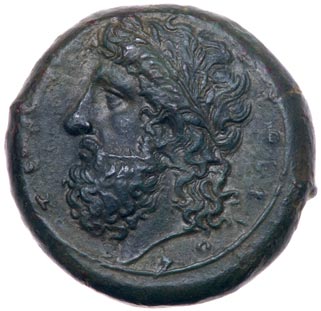 |
Sicily, Syracuse. Timoleon and the Third Democracy. Æ Dilitron, 25mm (20.01 g), 344-317 BC. Timoleontic Symmachy coinage, ca. 339/8-334 BC. ZE[YΣ EΛEY]ΘEPIOΣ, laureate head of Zeus Eleutherios left. Reverse: ΣYPA-K-OΣIΩ-N, horse galloping left. Castrizio series II, 1; CNS 80; SNG ANS 533-41. Lovely green patina. Superb Extremely Fine. Estimated Value $1,500 - UP
After decades of suffering under the tyrants Dionysios I, his son Dionysios II, and Hiketas of Leontinoi, in 344 BC the Syracusans had finally had enough and begged for aid from Corinth, the mother-city of Syracuse. Corinth responded by dispatching Timoleon at the head of a Peloponnesian mercenary army in order to overthrow the tyrants and establish a new democratic constitution. By 343 BC, Timoleon had expelled both Hiketas and Dionysios II and began the work of destroying the symbols of the former tyrannies and restoring constitutional government at Syracuse. However, while Dionysios II had surrendered and quietly went into opulent retirement at Corinth, Hiketas remained at large and called in support from Carthage. Although Hiketas received a great Punic army to sweep him back to power, this was defeated by Timoleon and his much smaller force while attempting to cross the Krimissos River in 339 BC. Having expelled the tyrants, restored good government, and freed Greek Sicily from the Punic menace, Timoleon promptly retired to private life.
Ex Goldberg 117 (15 September 2020), 2011; Roma XVIII (29 September 2019), 533.
View details and enlarged photos
Unsold |
|
Lot 17 |
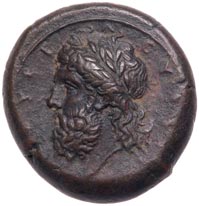 |
Sicily, Syracuse. Timoleon and the Third Democracy. Æ Dilitron, 25 mm (19.29 g), 344-317 BC. Timoleontic Symmachy coinage, ca. 339/8-334 BC. ZEYΣ EΛEYΘEPIOΣ, laureate head of Zeus Eleutherios left. Reverse: ΣYPAKOΣIΩ-N, horse galloping left. Castrizio series II, 1; CNS 80; SNG ANS 533-41. Wonderful high-relief portrait of Zeus. Pleasing reddish-brown patina. Extremely Fine. Estimated Value $500 - UP
Purchased by the consignor privately from Brian Kritt in 1998.
View details and enlarged photos
Realized
$504 |
|
Lot 18 |
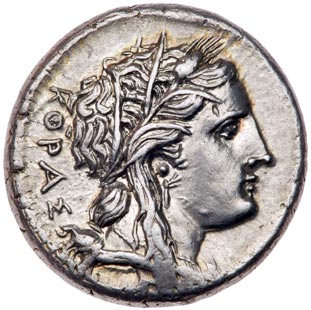 |
Sicily, Syracuse. Agathokles. Silver Tetradrachm (16.90 g), 317-289 BC. Ca. 310/08-306/5 BC. KOPAΣ, wreathed head of Kore right, wearing single-pendant earring and necklace. Reverse: AΓAΘOKΛEOΣ in exergue, Nike standing right, and erecting trophy; to left, AN or AV monogram; to right, triskeles. Ierardi 215 (O59/R145); SNG ANS 679 (same obv. die). Boldly struck on a broad flan with underlying luster. Superb. Nearly Mint State. Estimated Value $3,000 - UP
The image of Nike erecting a trophy on the reverse of this handsome tetradrachm is thought to advertise the successes that Agathokles had enjoyed in defending Syracuse against a massive Carthaginian blockade (actually the work of his older brother, Antander) and in carrying the war against Carthage to Punic Libya in 310-307 BC. The type, however, gives no indication that when things began to sour in Libya, Agathokles quietly abandoned his troops and sailed home. Despite this unspoken truth, the iconography quickly seized the attention of contemporary Hellenistic rulers much further to the east, where the image of Nike erecting a trophy provided the model for a similar scene found on tetradrachms of Seleukos I Nikator (312-281 BC), probably struck shortly after the decisive Battle of Ipsos in 301 BC. As these coins were struck primarily in Susa, the influence of Agathokles seems to have spread quite far indeed.
Ex Roma XIX (26 Mrch 2020), 302; CNG XXXIV (6 May 1995), 37; Athena Fund, Sotheby's Zurich (27 October 1993), 275.
View details and enlarged photos
Realized
$11,700 |
|
Lot 19 |
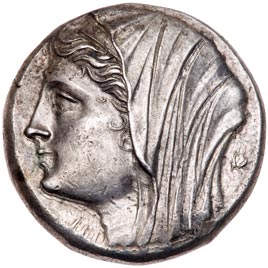 |
Sicily, Syracuse. Philistis, wife of Hieron II. Silver 16 Litrai (13.56 g), 275-215 BC. Under Hieron II, ca. 218/7-215 BC. Diademed and veiled head of Philistis left; behind, wreath. Reverse: BAΣIΛIΣΣAΣ ΦIΛIΣTIΔOΣ, Nike driving quadriga right, holding reins; above, Φ. CCO 166 (D10/R21); BAR issue 65; SNG ANS 874 (same rev. die); HGC 2, 1556. Wonderful metal. Lightly toned. Extremely Fine. Estimated Value $2,500 - UP
Philistis, the wife of Hieron II of Syracuse, is known by name only from the coins struck in her name and from a Greek inscription on the theater of Syracuse. While the quadriga type on the reverse had been traditional for Syracusan silver since the fifth century BC, the obverse portrait of the queen is very contemporary and Hellenistic in style. The representation of Philistis veiled and wearing the diadem (the Hellenistic symbol of royal status par excellence) is very much inspired by depictions of Arsinoe II on Ptolemaic gold coins. This is perhaps not overly surprising since Syracuse and Ptolemaic Egypt together dominated the western Mediterranean grain export trade and Hieron II is known to have been on very friendly terms with Ptolemy III. However, whereas Arsinoe II is clearly deified on Ptolemaic coins, Philistis here is merely idealized. She is clearly a queen, but not a goddess. This humble quality is perhaps to be expected for the depiction of a queen whose husband rose first from the status of a military commander to that of tyrant, and then to king.
From the Century Collection; Ex Enna Burnett Hoard Ex The Century Collection.
View details and enlarged photos
Realized
$3,840 |
|
Lot 20 |
 |
Sicily, Syracuse. Philistis, wife of Hieron II. Silver 16 Litrai (13.03 g), 275-215 BC. Under Hieron II, ca. 218/7-215 BC. Diademed and veiled head of Philistis left; behind, star. Reverse: BAΣIΛIΣΣAΣ ΦIΛIΣTIΔOΣ, Nike driving quadriga right, holding reins; above, crescent; in right field, A. CCO - (D20/R"21" unlisted die combination, matches second instance of D21 noted for CCO 213, but it is actually a different die); BAR issue 65; HGC 2, 1555. Excellent details. Choice Very Fine. Estimated Value $1,000 - UP
Ex CNG E484 (27 January 2021), 75.
View details and enlarged photos
Unsold |
|
Lot 21 |
 |
Sicily, Syracuse. Hieron II. Æ 27 (16.41 g), 275-215 BC. Ca. 230-218/5 BC. Diademed head of Hieron II left; behind, sphinx seated right. Reverse: IEPΩNOΣ, horseman riding right, holding spear; below, monogram. CNS -; BAR issue 62; SNG ANS -. Gorgeous green patina. An unpublished control variety. Superb Extremely Fine. Estimated Value $500 - UP
Ex Roma XVIII (29 September 2019), 539.
View details and enlarged photos
Realized
$630 |
|
Lot 22 |
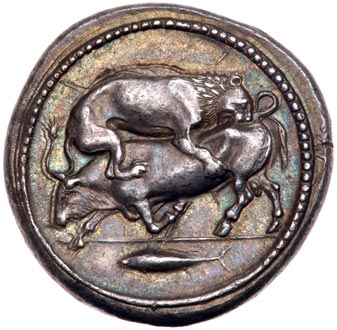 |
Macedonia, Akanthos. Silver Tetradrachm (17.11 g), ca. 425 BC. Lion right attacking bull collapsing left; in exergue, fish left. Reverse: AKANΘION, in shallow incuse around quadripartite square, the quarters raised and granulated. AMNG III/2, 21; cf. Desneux 99 (D -/R89; obv. die not recorded). Beautiful iridescent cabinet tone. A candidate for finest known. Superb. Nearly Mint State. Estimated Value $12,500 - UP
The image of the lion attacking a bull on this coin of Akanthos is executed masterfully and conveys the full power and violence of the scene as if the engraver had just been watching it unfold outside the window of his workshop. The great detail of the animals' musculature and the lion's mane give the image a vibrancy only found in Archaic Greek art. One can even imagine the bull helplessly screaming for the king of beasts to stop. The lion seems to make no reply except to sink his teeth further into his prey. While the type gives the impression of close attention to the natural world, by the time it appears on Greek coins it was already a stock image in Iranian art, perhaps reflecting the dualistic principles of Persian Zoroastrian religion.
Ex Roma XVIII (29 September 2019), 569.
View details and enlarged photos
Unsold |
|
Lot 23 |
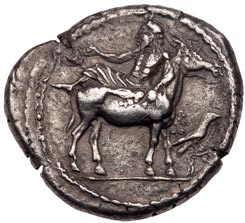 |
Macedonia, Mende. Silver Tetradrachm (17.19 g), ca. 460-425 BC. Dionysos, inebriated, reclining left on back of ass standing right; to right, magpie standing right on ivy. Reverse: MEN-Δ-A-IO-N, vine with five grape bunches; all within shallow incuse square. Noe 73; SNG ANS 340. Rare. Some minor porosity. Choice Very Fine. Estimated Value $3,500 - UP
The city of Mende was famous in antiquity for the wine that it exported. Thus it is not surprising that a large vine heavy with succulent grapes was chosen as the badge for the reverse of this tetradrachm, while the obverse the god of the vine, Dionysos or, perhaps, Selinos. The latter was a rustic deity and the father or grandfather of both the satyrs and the nymphs and spent most of his time completely drunk. Indeed, he was usually so drunk that he needed to be supported by satyrs or, as on this coin, by an ass. When the wine god Dionysos was born from the thigh of Zeus, Hermes placed the infant in the care of Silenos - after all, who else more suited to raising the god of wine than a drunken satyr - who became his tutor and was a prominent figure in the Dionysiac thiasos (retinue).The additional bird on this tetradrachm alludes to the early coinage of the city, which often featured an ass with a bird (commonly described as a crow, but now identified as a jay/magpie by J. Kagan) pecking at its rump. It also connects the tetradrachm through types to a contemporary fractional series featuring the bird on the reverse.
Ex NAC 123 (9 May 2021), 189; Stack's (3 December 1996), 485.
View details and enlarged photos
Unsold |
|
Lot 24 |
 |
Macedonian Kingdom. Philip II. Silver Tetradrachm (14.50 g), 359-336 BC. Pella, ca. 348/7-342/2 BC. Lifetime issue. Laureate head of Zeus right. Reverse: ΦIΛIΠΠOY, youth on horseback right, jockey holding palm branch. Le Rider Plate 7 166b (O-102, R-136). A masterpiece of Philip II! Boldly struck in high relief, and of exceptionally fine style. Lightly toned. NGC AU*, Strike: 5/5, Surface: 4/5 Fine Style. The realistic portrait of Philip II is absolutely amazing. Another masterpiece of Greek finest style portraiture. Superb Extremely Fine. Estimated Value $10,000 - UP
The tetradrachms of Philip II circulated in Macedonia as well as beyond the borders of the kingdom, particularly to the north, where they were popular with a variety of Thracian, Dacian and Celtic peoples. They inspired numerous Celtic and other imitative issues and were often the preferred coinage of mercenaries outside of the Macedonian kingdom. Due to their wide circulation and special popularity in some regions, the tetradrachms of Philip II continued in production long after Philip, and even his son Alexander the Great, were dead.
Ex Sotheby's (December 1994), 16 Ex The Century Collection.
View details and enlarged photos
Realized
$9,900 |
|
Lot 25 |
 |
Macedonian Kingdom. Philip II. Silver Tetradrachm (14.35 g), 359-336 BC. Pella, ca. 323/2-315 BC. Laureate head of Zeus left. Reverse: ΦIΛIΠΠOY, youth on horseback right, holding palm branch; below, Θ. Le Rider plate 19 #440, D231; A masterpiece! Fine style portrait struck in high relief. Lustrous and lightly toned. NGC grade AU*; Strike: 5/5, Surface: 4/5. Fine style. Estimated Value $10,000 - UP
The reverse type of this tetradrachm is of great historical importance because it represents a notable incident that is recorded in the life of Philip II. In 356 BC, a horse that the Macedonian king had entered in the 106th Olympic games was victorious. This coin depicts this winning horse along with its diminutive jockey holding the palm branch of victory. The type is also notable as a punning symbol to represent the king�s name. Philip literally means "lover of horses" in Greek.
Ex Sotheby's (12 December 1994), 15 Ex The Century Collection.
View details and enlarged photos
Unsold |
|
Lot 26 |
 |
Macedonian Kingdom. Philip II. Silver Tetradrachm (14.32 g), 359-336 BC. Amphipolis, ca. 316-311 BC. Laureate head of Zeus right. Reverse: ΦIΛIΠ-ΠOY, youth on horseback right, holding palm branch; below horse's belly, aplustre; below raised foreleg, Π-pellet monogram. Le Rider pl. 46, 17; Troxell grp. 9, 323-5; SNG ANS 738-46. Superb, and of the finest style for this Amphipolitan issue! Perfectly centered and beautifully toned with natural iridescence, and struck in high relief. An exceptional piece. Mint State. Estimated Value $2,000 - UP
View details and enlarged photos
Realized
$3,600 |
|
Lot 27 |
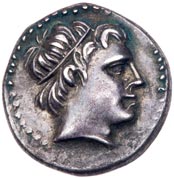 |
Macedonian Kingdom. Philip II. Silver 1/5 Tetradrachm (2.28 g), 359-336 BC. Amphipolis, ca. 310-290 BC. Head of Apollo right, wearing tainia. Reverse: ΦIΛIΠΠOY, Horseman riding right; below, club. Le Rider pl. 48, 12; SNG ANS 826. Lovely style and attractive old cabinet tone. Superb Extremely Fine. Estimated Value $350 - UP
From the Century Collection Ex The Century Collection.
View details and enlarged photos
Unsold |
|
Lot 28 |
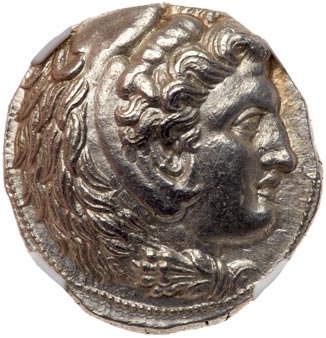 |
Macedonian Kingdom. Alexander III 'the Great'. Silver Tetradrachm (17.14 g), 336-323 BC. Susa, under Antigonos I Monopthalmos, 316-311 BC. Head of Herakles right, wearing lion's skin headdress. Reverse: BAΣIΛEΩΣ AΛEΞANΔPOY, Zeus seated left, holding eagle and scepter; in left field, wreath; below throne, above strut, AI; below strut, monogram. Price 3857. Wonderfully fine style with a needle sharp strike and in exceptionally high relief. Fully lustrous. Superb. NGC grade MS; Strike: 5/5, Surface: 4/5. Fine style. Estimated Value $2,500 - UP
Purchased by the consignor privately from Antiqua at NYINC 1990s.
View details and enlarged photos
Realized
$3,720 |
|
Lot 29 |
 |
Macedonian Kingdom. Alexander III 'the Great'. Silver Tetradrachm (17.18 g), 336-323 BC. Kyzikos, ca. 280-275 BC. Head of Herakles right, wearing lion's skin headdress. Reverse: AΛEΞANΔPOY, Zeus seated left, holding eagle and scepter; in left field, torch and monogram; below throne, monogram. Price 1340. Beautiful fine style. Excellent metal and lightly toned. Superb Extremely Fine. Estimated Value $2,000 - UP
Situated adjacent to the mouth of the river Aisepos on the southwest shore of the Propontis, Kyzikos was purported to be the first in a long line of Milesian colonies. The city possessed two fine harbors, both contributing greatly to its growth and prosperity. Traders plying the routes between the Aegean and Black Seas often stopped at Kyzikos to load tunnies, a main export as the fish were plentiful in the waters thereabouts.This beautiful tetradrachm was struck early in the 3rd century BC and utilizes the types of Alexander the Great's coinage. The head of Herakles is in high relief, and skillfully modeled with a lifelike semblance. Perfect centering along with th sharp, clear details of the designs, and the lovely overall style of the engraving should draw strong attention to this lovely coin.
Ex Goldberg 106 (4 September 2018), 1035; Lee Rousseau Collection.
View details and enlarged photos
Realized
$5,280 |
|
Lot 30 |
 |
Macedonian Kingdom. Alexander III 'the Great'. Silver Tetradrachm (17.11 g), 336-323 BC. Aigai(?), ca. 332-323 BC. Head of Herakles right, wearing lion's skin headdress. Reverse: AΛEΞANΔPOY, Zeus seated left, holding eagle and scepter; in left field, pankratiast standing left in 'guard' position. Price 187; Noe, Sicyon 3. Very Rare. Fine style and boldly struck in high relief. Old cabinet toning. Extremely Fine. Estimated Value $1,000 - UP
Ex Tareq Hani Collection.
View details and enlarged photos
Realized
$1,740 |
|
Lot 31 |
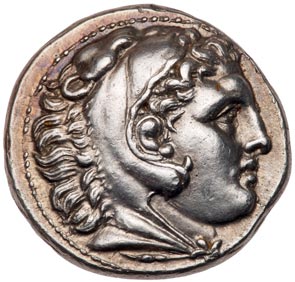 |
Macedonian Kingdom. Alexander III 'the Great'. Silver Tetradrachm (17.23 g), 336-323 BC. Amphipolis, ca. 310-307 BC. Head of Herakles right, wearing lion's skin headdress. Reverse: AΛEΞANΔPOY, Zeus seated left, holding eagle and scepter; to left, Λ over T above torch; below throne, E. Price 440; Ehrhardt 20. A hint of golden tone about the border. Excellent metal. Superb Extremely Fine. Estimated Value $600 - UP
View details and enlarged photos
Realized
$3,360 |
|
Lot 32 |
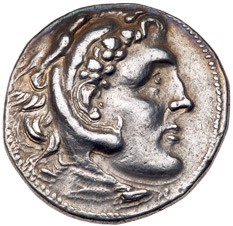 |
Macedonian Kingdom. Alexander III 'the Great'. Silver Tetradrachm (16.81 g), 336-323 BC. Mint of Rhodes. Teisylos, magistrate. Head of Herakles right, wearing lion's skin headdress. Reverse: AΛEΞANΔPOY, Zeus seated left, holding eagle and scepter; to left, magistrate's name TEIΣYΛOΣ above rose; below throne, PO. Ashton 252; Price 2520. Excellent metal. Extremely Fine. Estimated Value $500 - UP
View details and enlarged photos
Realized
$1,500 |
|
Lot 33 |
 |
Macedonian Kingdom. Alexander III 'the Great'. Silver Tetradrachm (1.07 g), 336-323 BC. Mint of Mesambria, ca. 100-72/1 BC. Head of Herakles right, wearing lion's skin headdress. Reverse: BAΣIΛEΩΣ AΛEΞANΔPOY, Zeus seated left, holding eagle and scepter; in left field, API above helmet right; HΦ monogram below throne. Karayotov I -; Callataÿ grp. 3, -; cf. Price 1112 (monogram). Attractive light toning with underlying luster present. NGC grade Ch AU; Strike: 5/5, Surface: 4/5. Estimated Value $400 - UP
View details and enlarged photos
Unsold |
|
Lot 34 |
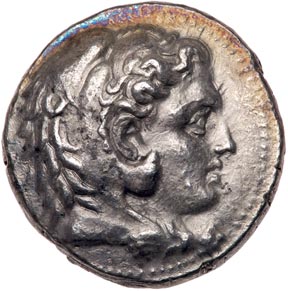 |
Macedonian Kingdom. Philip III Arrhidaios. Silver Tetradrachm (17.06 g), 323-317 BC. Babylon, ca. 323-318/7 BC. Head of Herakles right, wearing lion's skin headdress. Reverse: ΦIΛIΠΠOY, Zeus seated left, holding eagle and scepter; in left field, M; below throne, ΛY above strut. Price P181. Toned. Extremely Fine. Estimated Value $500 - UP
View details and enlarged photos
Realized
$630 |
|
Lot 35 |
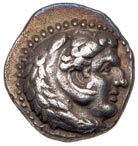 |
Macedonian Kingdom. Philip III Arrhidaios. Silver Hemidrachm (2.04 g), 323-317 BC. Susa, ca. 320-317 BC. Head of Herakles right, wearing lion's skin headdress. Reverse: ΦIΛIΠΠOY, Zeus seated left, holding eagle and scepter; below throne, ΛA above strut. Price P210. Rare. Toned. Extremely Fine. Estimated Value $500 - UP
View details and enlarged photos
Realized
$750 |
|
Lot 36 |
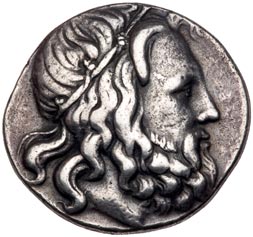 |
Macedonian Kingdom. Antigonos III Doson. Silver Tetradrachm (16.74 g), 229-221 BC. Amphipolis, ca. 227-225 BC. Head of Poseidon right, wreathed with marine plants. Reverse: BAΣIΛEΩΣ ANTIΓONOY inscribed on side of prow, Apollo seated left on prow, testing arrow; below, monogram. Panagopoulou 205 (O34/R196); Touratsoglou 52-3; SNG Alpha Bank 1046-7; SNG Saroglos 933. Rich toning, darkening within the recesses. Very Fine. Estimated Value $2,000 - UP
Ex Davissons 41 (16 March 2022), 30, and noted as being from an American collection formed in the 1950s primarily from Spink (Messrs. French and Forrer) in London, NFA (Edward Gans) in New York, and Earle K. Stanton in Los Angeles.
View details and enlarged photos
Unsold |
|
Lot 37 |
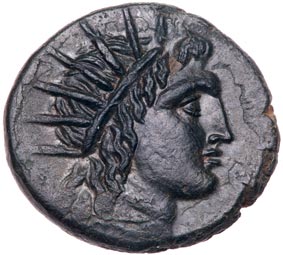 |
Macedonian Kingdom. Philip V. Æ (12.12 g), 221-179 BC. Pella or Amphipolis. Radiate head of Helios right. Reverse: BAΣIΛEΩΣ ΦIΛIΠΠOY, winged thunderbolt; ΔI monogram above, two monograms below; all within oak-wreath. Mamroth 24d; Touratsoglou 20; HGC 3, 1062. Dark green patina. A fantastic piece! Mint State. Estimated Value $400 - UP
From the Century Collection Ex The Century Collection.
View details and enlarged photos
Realized
$660 |
|
Lot 38 |
 |
Paeonian Kingdom. Patraos. Silver Tetradrachm (12.64 g), 335-315 BC. Damastion(?). Laureate head of Apollo right. Reverse: Π-A-P-TAY (sic), warrior on horseback right, riding down enemy below with lance. Paeonian Hoard 490 (same dies); SNG ANS 1040 (same obv. die). Excellent details and attractively toned. Extremely Fine. Estimated Value $500 - UP
View details and enlarged photos
Realized
$990 |
|
Lot 39 |
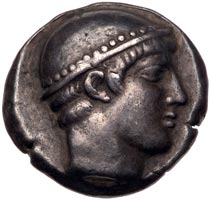 |
Thrace, Ainos. Silver Tetradrachm (15.51 g), ca. 463/2-462/1 BC. Head of Hermes right, wearing petasos. Reverse: AINI, Goat standing right; before, dog standing right; all within incuse square. Cf. May, Ainos 28-9; HGC 3.2, 1266. Rare. Nicely toned and struck in lovely high relief. Very Fine. Estimated Value $3,500 - UP
Ex Obols 20 (3 October 2021), 593.
View details and enlarged photos
Realized
$5,520 |
|
Lot 40 |
 |
Thracian Kingdom. Lysimachos. Silver Tetradrachm (17.17 g), as King, 306-281 BC. Lampsakos, ca. 297/6-282/1 BC. Diademed head of deified Alexander right, with horn of Ammon. Reverse: BAΣIΛEΩΣ ΛYΣIMAΧOY, Athena seated left, holding Nike and resting elbow on shield at side, spear leaning against far shoulder; in inner left field, long torch; on side of throne, star. Thompson 43; SNG BN 2538-9; Müller 381 (Kyzikos). A magnificent example, with light iridescent toning and mirror-like luster. Nearly Mint State. Estimated Value $5,000 - UP
This coin features an iconic early Hellenistic portrait of Alexander the Great that transcended all borders and the limits of mere geography. Not only did it become the preferred type for coins struck for use in Thrace long after Lysimachos' death, but it even appears on a gem from a seal ring produced in Central Asia.
Ex Roma XVIII (29 Septmber 2019), 583.
View details and enlarged photos
Realized
$12,600 |
|
Lot 41 |
 |
Thracian Kingdom. Lysimachos. Silver Tetradrachm (17.04 g), as King, 306-281 BC. Pella(?), ca. 286/5-282 BC. Diademed head of deified Alexander right, with horn of Ammon. Reverse: BAΣIΛEΩΣ ΛYΣIMAΧOY, Athena seated left, holding Nike and resting elbow on shield at side, spear leaning against far shoulder; in inner left field, ΛO monogram. Thompson -; Müller 249 (Kallatis). Nice compact style and struck in high relief. Choice Very Fine. Estimated Value $1,500 - UP
While this variety is not included in Thompson, and Müller includes it under Kallatis, the style of the portrait has strong affinities to the coins from Pella in Macedonia.
View details and enlarged photos
Unsold |
|
Lot 42 |
 |
Thracian Kingdom. Lysimachos. Silver Tetradrachm (17.06 g), as King, 306-281 BC. Lampsakos, ca. 297/6-282/1 BC. Diademed head of deified Alexander right, with horn of Ammon. Reverse: BAΣIΛEΩΣ ΛYΣIMAΧOY, Athena seated left, holding Nike and resting elbow on shield at side, spear leaning against far shoulder; in inner left field, ΔΞ monogram; in exergue, crescent. Thompson 49; SNG BN 2549; Müller 399. Lightly toned with traces of luster. Nearly Extremely Fine. Estimated Value $1,500 - UP
View details and enlarged photos
Unsold |
|
Lot 43 |
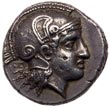 |
Thessaly, Pharsalos. Silver Drachm (5.98 g), ca. 420-390 BC. Signed by the engraver Telephantos and his pupil "Φ"�. Head of Athena right, wearing crested Attic helmet with upturned cheek flaps; TH and IΠ behind neck guard. Reverse; Φ-A-P-(Σ), Thessalian warrior on horseback right. Lavva 132 (this coin). Fine style. Old cabinet tone. A couple of minor flan flaws on check. About Extremely Fine. Estimated Value $1,500 - UP
Ex BCD Collection, Ex GMRH (Ashmolean Museum Duplicates Sale), May 1978 (comes with old Collection tags).
View details and enlarged photos
Unsold |
|
Lot 44 |
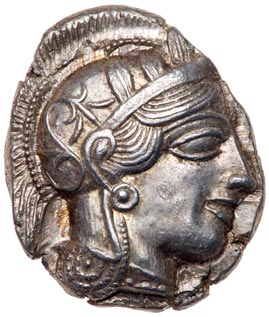 |
Attica, Athens. Silver Tetradrachm (17.19 g), ca. 454-404 BC. Helmeted head of Athena right, frontal eye. Reverse: AΘE, owl standing right, head facing; above to left, olive-spray with berry and crescent; all within incuse square. Kroll 8; Svoronos pl. 14; SNG Copenhagen 31-40. Rich golden iridescent toning and fully lustrous. Mint State. Estimated Value $2,000 - UP
View details and enlarged photos
Unsold |
|
Lot 45 |
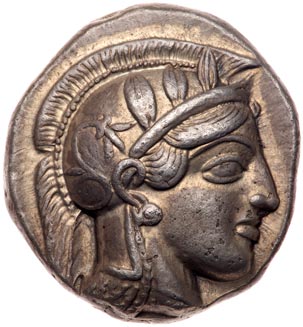 |
Attica, Athens. Silver Tetradrachm (17.14 g), ca. 454-404 BC. Helmeted head of Athena right, frontal eye. Reverse: AΘE, owl standing right, head facing; above to left, olive-spray with berry and crescent; all within incuse square. Kroll 8; Svoronos pl. 14; SNG Copenhagen 31-40. Lovely compact style, struck in high relief, perfectly centered and delicately toned. Superb Extremely Fine. Estimated Value $1,000 - UP
View details and enlarged photos
Realized
$2,640 |
|
Lot 46 |
 |
Attica, Athens. Silver Tetradrachm (17.16 g), ca. 454-404 BC. Helmeted head of Athena right, frontal eye. Reverse: AΘE, owl standing right, head facing; above to left, olive-spray with berry and crescent; all within incuse square. Kroll 8; Svoronos pl. 14; SNG Copenhagen 31-40. Well centered. Extremely Fine. Estimated Value $750 - UP
Ex The Century Collection.
View details and enlarged photos
Realized
$1,800 |
|
Lot 47 |
 |
Attica, Athens. Silver Tetradrachm (17.21 g), ca. 454-404 BC. Helmeted head of Athena right, frontal eye. Reverse: AΘE, owl standing right, head facing; above to left, olive-spray with berry and crescent; all within incuse square. Kroll 8; Svoronos pl. 14; SNG Copenhagen 31-40. Lustrous and boldly struck. Extremely Fine. Estimated Value $750 - UP
From the Century Collection Ex The Century Collection.
View details and enlarged photos
Realized
$990 |
|
Lot 48 |
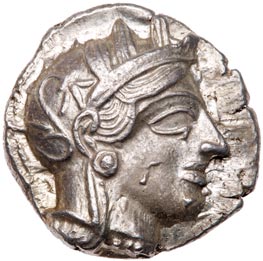 |
Attica, Athens. Silver Tetradrachm (17.17 g), ca. 454-404 BC. Helmeted head of Athena right, frontal eye. Reverse: AΘE, owl standing right, head facing; above to left, olive-spray with berry and crescent; all within incuse square. Kroll 8; Svoronos pl. 14; SNG Copenhagen 31-40. Lustrous and well centered. Virtually as struck. Superb Extremely Fine. Estimated Value $750 - UP
From the Century Collection Ex The Century Collection.
View details and enlarged photos
Realized
$930 |
|
Lot 49 |
 |
Attica, Athens. Silver Tetradrachm (17.17 g), ca. 454-404 BC. Helmeted head of Athena right, frontal eye. Reverse: AΘE, owl standing right, head facing; above to left, olive-spray with berry and crescent; all within incuse square. Kroll 8; Svoronos pl. 14; SNG Copenhagen 31-40. Well centered with a full crest. Extremely Fine. Estimated Value $750 - UP
From the Century Collection Ex The Century Collection.
View details and enlarged photos
Realized
$840 |
|
Lot 50 |
 |
Athens. Silver Drachm (3.99 g), ca. 454-404 BC. Helmeted. Helmeted head of Athena right, with frontal eye. Reverse; AΘE, Owl standing right, olive sprig behind, all within incuse square. Kroll 10; HGC 4, 1631. Somewhat grainy. Choice Very Fine. Estimated Value $300 - UP
View details and enlarged photos
Realized
$432 |
|
|
|